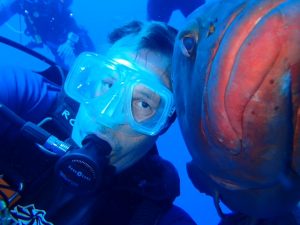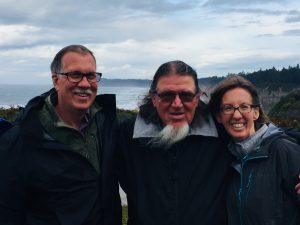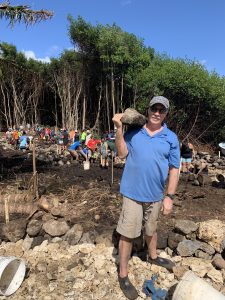April 7, 2023
From the Summer 2023 Sea Star
Having served as director of Washington Sea Grant since 2018, Callender retires in April 2023
 “Ever since I was a teenager, my passion was for conservation,” says Russell Callender. He kept his love for preserving the environment close to heart throughout his career, which involved twists and turns from academic research to climbing the ranks of government, and becoming an executive leader at the National Oceanic and Atmospheric Administration (NOAA). In 2018, Callender moved from one Washington to the other to serve as the director for Washington Sea Grant (WSG), bringing with him decades of experience in marine science, environmental policy and program administration.
“Ever since I was a teenager, my passion was for conservation,” says Russell Callender. He kept his love for preserving the environment close to heart throughout his career, which involved twists and turns from academic research to climbing the ranks of government, and becoming an executive leader at the National Oceanic and Atmospheric Administration (NOAA). In 2018, Callender moved from one Washington to the other to serve as the director for Washington Sea Grant (WSG), bringing with him decades of experience in marine science, environmental policy and program administration.
In his time at WSG, Callender led the organization through structural changes and elevated program priorities, such as expanding capacity on the coast, building resilience, and diversity, equity and inclusion. Callender retired on April 7. In his last month at WSG, we had the chance to talk with him about the arc of his career, proudest accomplishments, and hopes for the future.
How did you start out your career in the marine sciences?
I started off wanting to be an academic scientist. I was a geologist. During my Ph.D., I had the opportunity to go in small submarines offshore of Louisiana to study the chemosynthetic organisms that were living off of oil and gas seepage. I loved getting out there and seeing the immensity of the oceans. When you get even a little offshore, the water is blue, blue, blue. Dropping down literally to the bottom of the ocean, in the dark, and being able to see a world that hardly anybody has really been able to see was mind-blowing. Once, we went to a brine pool, which is basically a dense, incredibly salty pocket of water that looks like a lake on the bottom of the ocean. Landing the submarine on the lake and seeing ripples come out, it was amazing. We were literally floating on a lake on the bottom of the sea
What led you out of academic research and into marine policy?
I had the opportunity to do the Knauss Marine Policy Fellowship through Texas Sea Grant, which took me to Washington, DC. I ended up working for the Oceanographer of the Navy’s Office. It opened my eyes to mission-focused science: I realized there was a big world of applied science. I also learned a lot about the politics of science — how science isn’t always as pure as you think it is, it’s driven a lot by political agendas.
I then got a junior staff position at NOAA. Part of what I did there was support the National Sea Grant Program. From there, I had the opportunity to move to be the deputy director of Virginia Sea Grant. I learned how to manage a science portfolio. I learned how to supervise. I learned how to run research competitions, and to manage an advisory committee. I wrote my first strategic plan. It was a really good foundation.
You ended up as an executive leader at the NOAA National Ocean Service. How did you get there?
I got a position back at NOAA and, as I interacted with senior leaders in the agency, I started to think: I could do that. I ended up getting the opportunity to run one of the coastal labs of the NOAA Ocean Service, which I did for about seven years. It was probably the best job of my life — I got paid to go scuba diving! And I learned how to build partnerships with other agencies, manage contracts, manage larger organizations, and how to lead and change those organizations.

Callender out on a dive.
Fast forward, I became the deputy of the parent organization that had all seven of the coastal labs. Ultimately, I moved up to be the assistant administrator of the Ocean Service, which was as high as I could go in government without being in a politically-appointed position. This meant managing multiple programs, each of which were about 200 to 300 people. I got to work on diverse things like mapping the ocean floor, collecting observations for the integrated ocean observing system, managing the country’s coastal zone program. I liked being focused on issues that made a difference — projects that preserved large swaths of ocean and incredible habitats or built relationships with other countries.
What made you decide to pivot your career and come to WSG?
I was leading a big, big program. I was working all the time, and I was traveling a lot. My whole life became about work. And I didn’t do a great job with other things. I was married and had a daughter . . . my wife got really sick and ultimately she passed away. My mom had been living with us, and she passed away before my wife. All of a sudden I was living in a huge house alone with a disabled daughter. Wondering, what the heck do I do now.
And then I had a medical crisis of my own. It really made me question what I was doing. I had done some things that I think made a big difference to the planet while I was in the Ocean Service. But it came at a big cost.
I’d always kind of kept an eye on WSG. I saw the announcement for the director position and realized, well, I love the oceans, I love mountains — I was a rock climber for 30-plus years and had climbed all over the US and in Europe — and I thought, I should apply for that. I ended up coming here and really got to reset my life. I think the hallmark of my career at every step along the way was taking chances. Taking the chance to go to the Oceanographers Office. Taking the chance to run a coastal lab. Taking a chance to run all of the National Ocean Service’s coastal labs. Taking the chance to be the director of a big organization. And then, taking that leap to head west to a better, more balanced life.
What excited you about the work of WSG?

From left: Callender, Ed Johnstone and Kate Litle.
I was excited by the diversity of ecosystems here. I knew there were challenges around ocean acidification and water quality concerns. I was really intrigued by trying to figure out how to work with tribes. Once I started here, it was amazing to get to learn from people who have lived and breathed in this space for millennia. I remember sitting on the beach with Ed Johnstone from the Quinault Indian Nation. Over a several-hour conversation, he spoke about the vulnerability of his tribe to tsunamis to issues like marine debris, warming seas, ocean acidification, and coastal erosion. He talked about the arrival of white colonists as if it were yesterday. It really made me shift my thinking about the importance of long-term relationships and long-term stewardship.
I had no idea that I would be able to be exposed to that kind of complexity. I had no idea how I would be exposed to the shellfish growing community, and to learn about their lives and challenges. Or to have heart-to-heart conversations with commercial fishermen about the passion they feel for ocean conservation and for the next generation. I got a much deeper understanding of this area and the people who live and work here, what drives them.
One of your passions is supporting coastal resilience. Can you describe your work in this area?
The planet is changing. We’ve got rising seas that are causing high tide events to push water onshore in places where there are homes, businesses and critical infrastructure like hospitals or schools. A warming planet means the atmosphere can hold more moisture, so we’re getting more intense rain events. We’re getting wild weather swings. When I was at NOAA, it seemed like the focus of coastal resilience was on restoring habitat, and I felt like there was a gap in terms of building resilience for people and communities. What about helping people understand the risks they will be facing, and how they can make changes to minimize those risks? If they get hammered by a flood or major storm, how can they recover more quickly?
At WSG, I put together a coastal resilience strategy and worked to get the entire Sea Grant Association to approve it. I developed budget priorities for the entire National Sea Grant Program that included resilience and DEIJA. I was able to talk about why this is important with the key Congressional staff. Moving things forward politically takes a long time; it might be ten years before this pays off. In the meantime, right now each Sea Grant program is going to get $125,000 tacked onto their base budget for coastal resilience for at least a six-year period. That’s not a ton of money, but I think I’ve helped to set the groundwork for more. There’s an unparalleled amount of money available through Congress right now to support a broad swath of coastal resilience activities. I’m hoping that through these opportunities we can collectively figure out how to better support people on the coast and the needs they have.
You really elevated diversity, equity and inclusion (DEI) initiatives at WSG and recently the UW recognized you and others for accomplishments in DEI. Tell us about your approach and philosophy to this work.
I grew up in the south. And I saw so many instances of abhorrent behavior and racial injustice. I didn’t understand it and was disgusted by it. And then, I became a father to a daughter with a cognitive disability, which really taught me about what inclusion means. When I interviewed at WSG and I asked about the DEI space, people lit up and I was like, this is the right spot. Once I got here, I realized how little I knew about the depth of issues of race and gender and inclusion and equality and social justice — but, through my position as a director, I realized I could be an enabler. I could support my team here to do more. As a leader, it’s about giving people the opportunity and the space to change the organization and to change thinking and behaviors. I’m humbled by this work every day.
What is one of your proudest accomplishments from your time at WSG?

Callender helping to restore an 800-year-old fish pond in He’eia.
Moving rocks. In early 2020, I went to He’eia in Hawaii to help restore an 800-year-old fishpond through the Indigenous Aquaculture Collaborative Network. When I was at NOAA, I had actually worked to get that area recognized as a national estuarine research reserve — conserved, hopefully, for all time. The area goes from the mountains to the streams to the fishponds to the reefs. To be able to run that initiative through the political system and advocate for it on Capitol Hill and then get the head of NOAA to approve it — and then, down the road, to get to go get in the mud and move rocks to support Indigenous-led stewardship . . . it was rewarding on a spiritual level.
What are you most looking forward to in retirement?
When I moved to Washington, an old friend from when I was running that coastal science lab joined me for the drive across the country. We had a lot of time for conversation . . . and we changed to being more than friends. On Valentine’s Day of 2020, we got engaged on a white sandy beach in Hawaii (I was hedging my bets…). And then the pandemic hit and it took us three tries to get married. So, part of my motivation for wanting to leave the workplace right now is to explore this new life and new relationship with a lovely woman. We’re going to hike, we’re going to cycle, we’re going to garden, we’re going to play in and under the saltwater. I’m looking forward to just enjoying life and passing the mantle of science and conservation to the next generation.
###
Washington Sea Grant, based at the University of Washington, helps people and marine life thrive through research, technical expertise and education supporting the responsible use and conservation of coastal ecosystems. The National Sea Grant College Program is part of the National Oceanic and Atmospheric Administration, U.S. Department of Commerce.
www.wsg.uw.edu.
Join the conversation: @WASeaGrant and Facebook.com/WaSeaGrant.
APR
2023